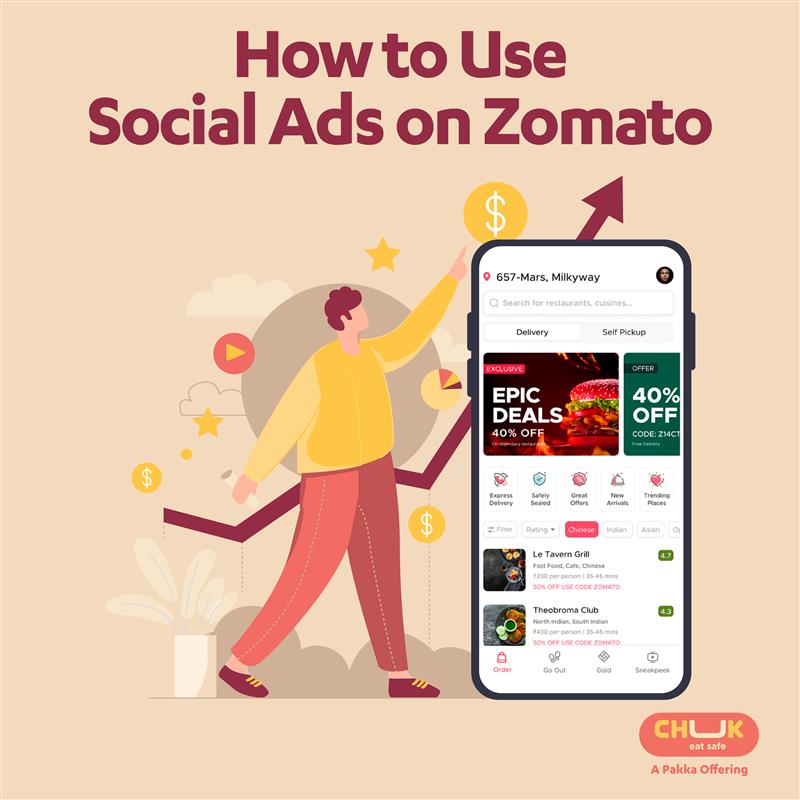Are you a restaurant owner with your business listed on Zomato? If yes, then you’re sitting on a treasure trove of potential customers! Zomato’s social ads feature is a fantastic way to get your restaurant noticed and increase sales. In this simple guide, we’ll walk you through how to leverage social ads on Zomato and make your restaurant a go-to spot for food lovers.
What are social ads on Zomato?
Social ads on Zomato are paid advertisements that appear on social media platforms like Facebook and Instagram, designed to drive traffic to your restaurant’s Zomato page. These ads are shown to users who are most likely to engage with them, based on their interests, location, and behavior.
Why should you use social ads on Zomato?
Let’s look at some numbers:
- Over 50 million active users engage with Zomato every month.
- 66% of Zomato users discover new restaurants through the app (Zomato Insights).
- 60% of people who see an ad on social media are likely to make a purchase based on it (Statista).
These statistics show just how much potential Zomato social ads have in bringing more customers to your restaurant. Let’s break down how you can use this feature step by step.
Step 1: Set up your Zomato restaurant profile
Before you can start running ads, ensure your restaurant’s Zomato profile is complete. Make sure your menu, photos, hours, and contact details are accurate. A well-optimized profile makes it easier for customers to find you.
Step 2: Understand your audience
Knowing your audience is crucial for running successful ads. Zomato allows you to target ads based on:
- Location: You can target people in your city or even specific neighbourhoods.
- Interests: Target foodies, vegans, or people looking for fine dining experiences.
- Demographics: Customize based on age, gender, and income groups.
Pro Tip: If your restaurant serves quick bites, target office goers or people who are likely to enjoy fast food. If you run a high-end restaurant, focus on food lovers who enjoy dining out.
Step 3: Choose the right ad format
Zomato offers various ad formats to suit different needs:
- Promoted restaurant listings: Your restaurant appears at the top of search results on Zomato.
- Sponsored ads on social media: Ads that show up on Facebook or Instagram feeds, driving traffic to your Zomato profile.
- Deals and offers: Showcase special discounts to attract more customers.
Pro Tip: If you’re running a special deal, sponsored social ads can highlight the offer, enticing people to visit your restaurant.
Step 4: Set your budget and duration
One of the best things about Zomato social ads is that you can set your own budget. Start small and experiment with different budgets to see what works best for you.
- Daily budget: Set how much you want to spend each day.
- Duration: Choose how long you want your ad campaign to run. It could be a day, a week, or even a month.
Pro Tip: Start with a budget of Rs. 500 – Rs. 1,000 per day to test your ad’s performance. Monitor how your customers are responding to adjust accordingly.
Step 5: Create engaging content for your ads
Good content is key! Here’s what you should focus on:
- High-quality images: Show off your best dishes.
- Clear call-to-action: Use phrases like “Order Now,” “Reserve a Table,” or “Claim Your Discount.”
- Targeted messaging: Speak directly to your audience’s desires. For example, if you’re promoting a dessert place, say “Craving something sweet? Order now!”
Pro Tip: If you have a special offer like “Buy 1 Get 1 Free on Pizzas,” highlight that offer in your ad. Use a photo of your pizza with a simple message: “Double the fun! Get 2 pizzas for the price of 1. Order now on Zomato!”
Step 6: Monitor and optimize your ads
Once your ads are live, track their performance using Zomato’s analytics tools. Pay attention to:
- Impressions: How many people saw your ad.
- Click-through rate (CTR): How many people clicked on your ad to visit your Zomato page.
- Conversion: How many people made a reservation or order after seeing your ad.
Tip: If an ad isn’t performing well, tweak the images, wording, or targeting options to improve results.
Real-life example: Successful restaurant campaigns
Let’s look at how some restaurants have successfully used Zomato social ads:
- SodaBottleOpenerWala (Mumbai): This iconic Mumbai-based restaurant saw a 40% increase in orders after running social media ads on Zomato targeting young professionals. They used vibrant images of their Parsi dishes to catch attention.
- The Beer Café (Delhi): By promoting their happy hour deals, they saw a 30% increase in walk-ins during the evening. Their targeted ads were tailored to people aged 22-35 who liked beer and socializing.
Step 7: Leverage Zomato’s analytics for better insights
Once you have your ad campaign running, use Zomato’s in-depth analytics to track key metrics:
- Total impressions: The number of times your ad was viewed.
- Engagement rate: The percentage of people who clicked on your ad after viewing it.
- ROI (return on investment): Calculate how much revenue your ad brought in compared to what you spent.
With the right insights, you can make informed decisions on how to adjust future campaigns.
Conclusion
Social ads on Zomato can significantly boost your restaurant’s visibility and bring in more customers. By following these simple steps—setting up your profile, understanding your audience, creating engaging content, and monitoring your performance—you can make the most out of this powerful tool.
Remember, with over 50 million users on Zomato, you have a huge opportunity to reach new customers. So, start today and make your restaurant the next hot spot in town!
Sources:
- Zomato Insights, 2023.
- Statista, 2023.


